Recruitment and Selection Report: Luton and IKEA - Processes
VerifiedAdded on 2020/07/23
|8
|2466
|218
Report
AI Summary
This report delves into the core processes of recruitment and selection, essential for organizations to identify and secure the best candidates. It begins by examining how organizations like Luton and IKEA plan recruitment using both internal and external sources, detailing the advantages and disadvantages of each approach. The report then analyzes the impact of legal and regulatory frameworks, including EU and UK legislation like the Equal Pay Act and Disability Discrimination Act, on recruitment practices. It provides a comprehensive overview of the documents used in the process, such as job descriptions and person specifications, and outlines the steps involved in planning and participating in a selection interview. The report emphasizes preparation, structuring the interview, and evaluating candidates. Finally, the report provides an in-depth conclusion and references.
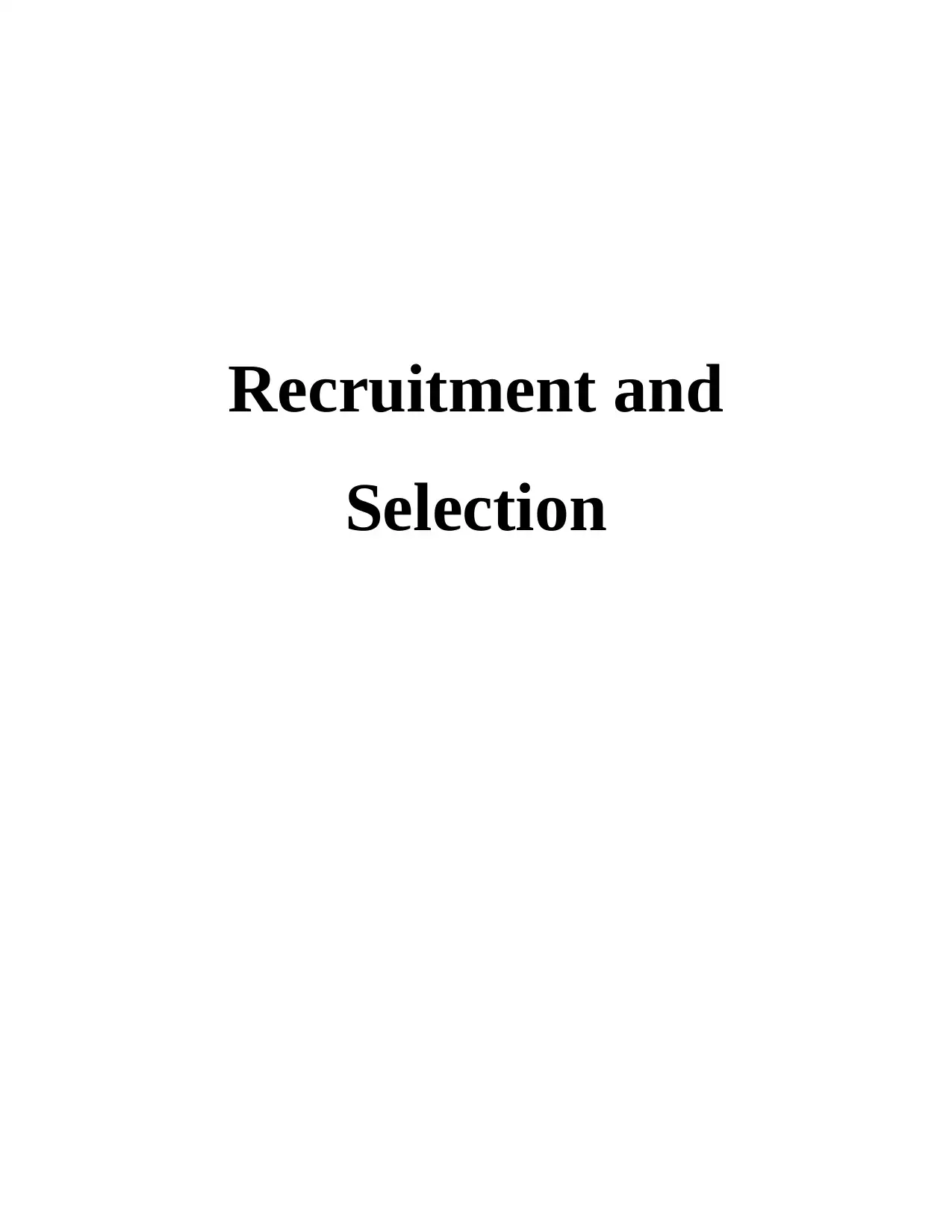
Recruitment and
Selection
Selection
Paraphrase This Document
Need a fresh take? Get an instant paraphrase of this document with our AI Paraphraser
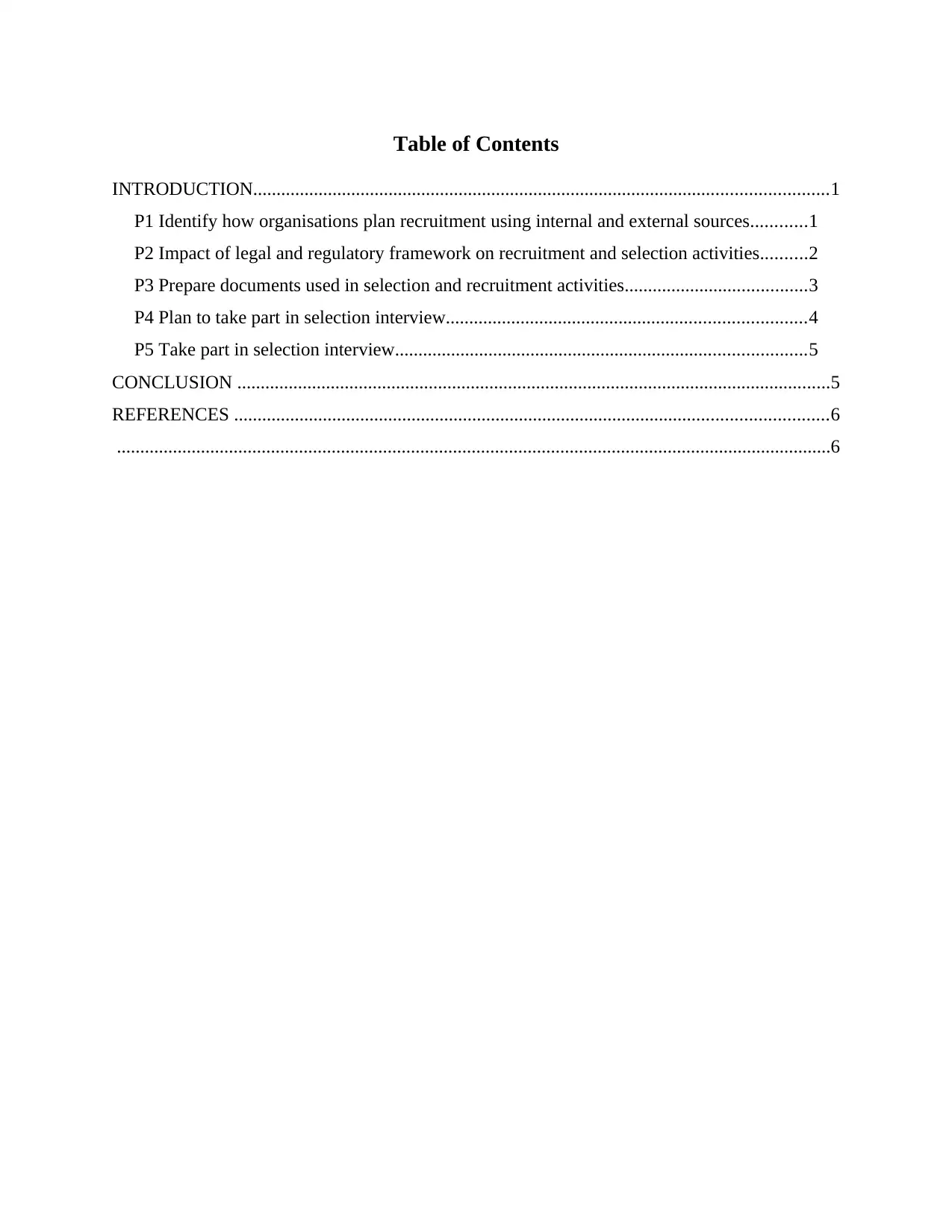
Table of Contents
INTRODUCTION...........................................................................................................................1
P1 Identify how organisations plan recruitment using internal and external sources............1
P2 Impact of legal and regulatory framework on recruitment and selection activities..........2
P3 Prepare documents used in selection and recruitment activities.......................................3
P4 Plan to take part in selection interview.............................................................................4
P5 Take part in selection interview........................................................................................5
CONCLUSION ...............................................................................................................................5
REFERENCES ...............................................................................................................................6
.........................................................................................................................................................6
INTRODUCTION...........................................................................................................................1
P1 Identify how organisations plan recruitment using internal and external sources............1
P2 Impact of legal and regulatory framework on recruitment and selection activities..........2
P3 Prepare documents used in selection and recruitment activities.......................................3
P4 Plan to take part in selection interview.............................................................................4
P5 Take part in selection interview........................................................................................5
CONCLUSION ...............................................................................................................................5
REFERENCES ...............................................................................................................................6
.........................................................................................................................................................6
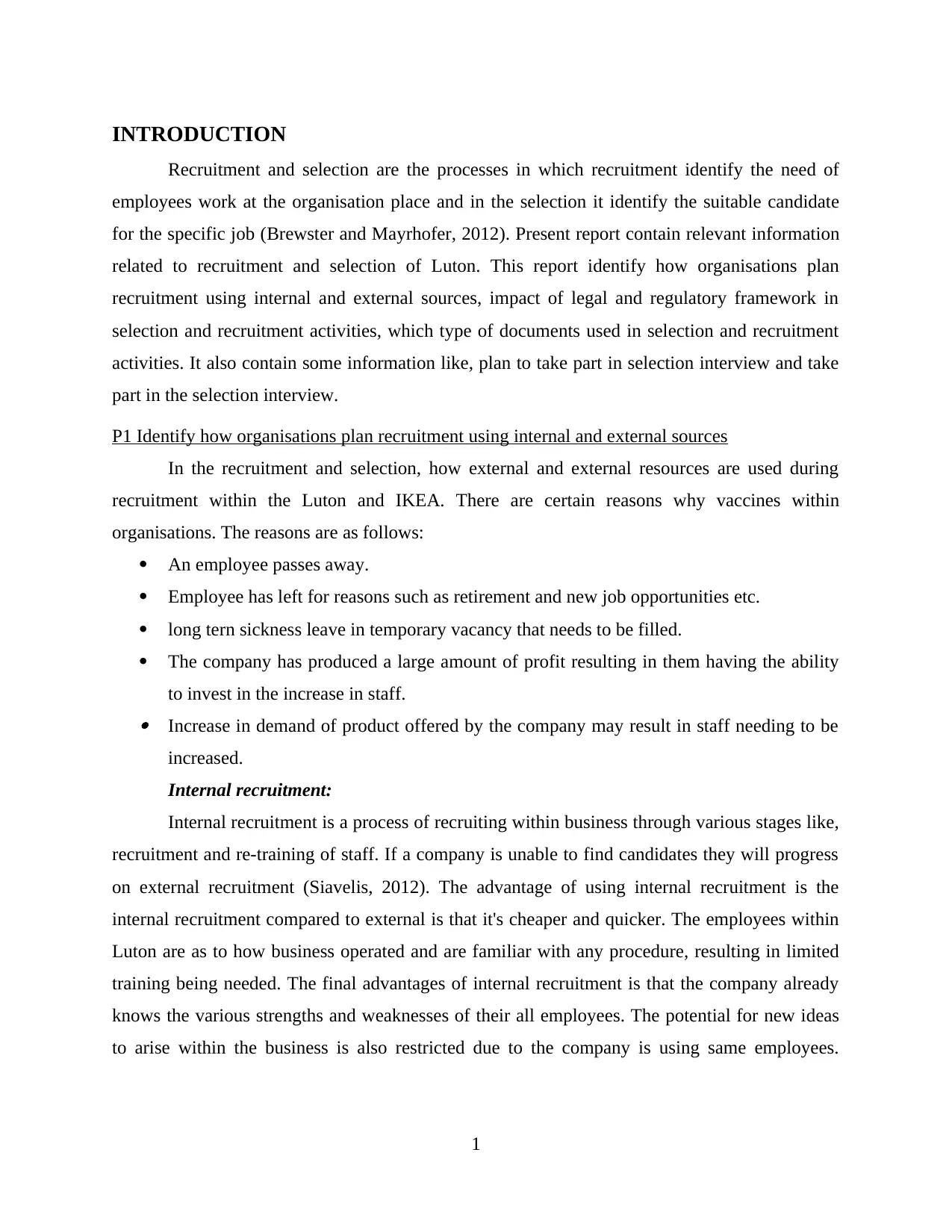
INTRODUCTION
Recruitment and selection are the processes in which recruitment identify the need of
employees work at the organisation place and in the selection it identify the suitable candidate
for the specific job (Brewster and Mayrhofer, 2012). Present report contain relevant information
related to recruitment and selection of Luton. This report identify how organisations plan
recruitment using internal and external sources, impact of legal and regulatory framework in
selection and recruitment activities, which type of documents used in selection and recruitment
activities. It also contain some information like, plan to take part in selection interview and take
part in the selection interview.
P1 Identify how organisations plan recruitment using internal and external sources
In the recruitment and selection, how external and external resources are used during
recruitment within the Luton and IKEA. There are certain reasons why vaccines within
organisations. The reasons are as follows:
An employee passes away.
Employee has left for reasons such as retirement and new job opportunities etc.
long tern sickness leave in temporary vacancy that needs to be filled.
The company has produced a large amount of profit resulting in them having the ability
to invest in the increase in staff. Increase in demand of product offered by the company may result in staff needing to be
increased.
Internal recruitment:
Internal recruitment is a process of recruiting within business through various stages like,
recruitment and re-training of staff. If a company is unable to find candidates they will progress
on external recruitment (Siavelis, 2012). The advantage of using internal recruitment is the
internal recruitment compared to external is that it's cheaper and quicker. The employees within
Luton are as to how business operated and are familiar with any procedure, resulting in limited
training being needed. The final advantages of internal recruitment is that the company already
knows the various strengths and weaknesses of their all employees. The potential for new ideas
to arise within the business is also restricted due to the company is using same employees.
1
Recruitment and selection are the processes in which recruitment identify the need of
employees work at the organisation place and in the selection it identify the suitable candidate
for the specific job (Brewster and Mayrhofer, 2012). Present report contain relevant information
related to recruitment and selection of Luton. This report identify how organisations plan
recruitment using internal and external sources, impact of legal and regulatory framework in
selection and recruitment activities, which type of documents used in selection and recruitment
activities. It also contain some information like, plan to take part in selection interview and take
part in the selection interview.
P1 Identify how organisations plan recruitment using internal and external sources
In the recruitment and selection, how external and external resources are used during
recruitment within the Luton and IKEA. There are certain reasons why vaccines within
organisations. The reasons are as follows:
An employee passes away.
Employee has left for reasons such as retirement and new job opportunities etc.
long tern sickness leave in temporary vacancy that needs to be filled.
The company has produced a large amount of profit resulting in them having the ability
to invest in the increase in staff. Increase in demand of product offered by the company may result in staff needing to be
increased.
Internal recruitment:
Internal recruitment is a process of recruiting within business through various stages like,
recruitment and re-training of staff. If a company is unable to find candidates they will progress
on external recruitment (Siavelis, 2012). The advantage of using internal recruitment is the
internal recruitment compared to external is that it's cheaper and quicker. The employees within
Luton are as to how business operated and are familiar with any procedure, resulting in limited
training being needed. The final advantages of internal recruitment is that the company already
knows the various strengths and weaknesses of their all employees. The potential for new ideas
to arise within the business is also restricted due to the company is using same employees.
1
⊘ This is a preview!⊘
Do you want full access?
Subscribe today to unlock all pages.

Trusted by 1+ million students worldwide
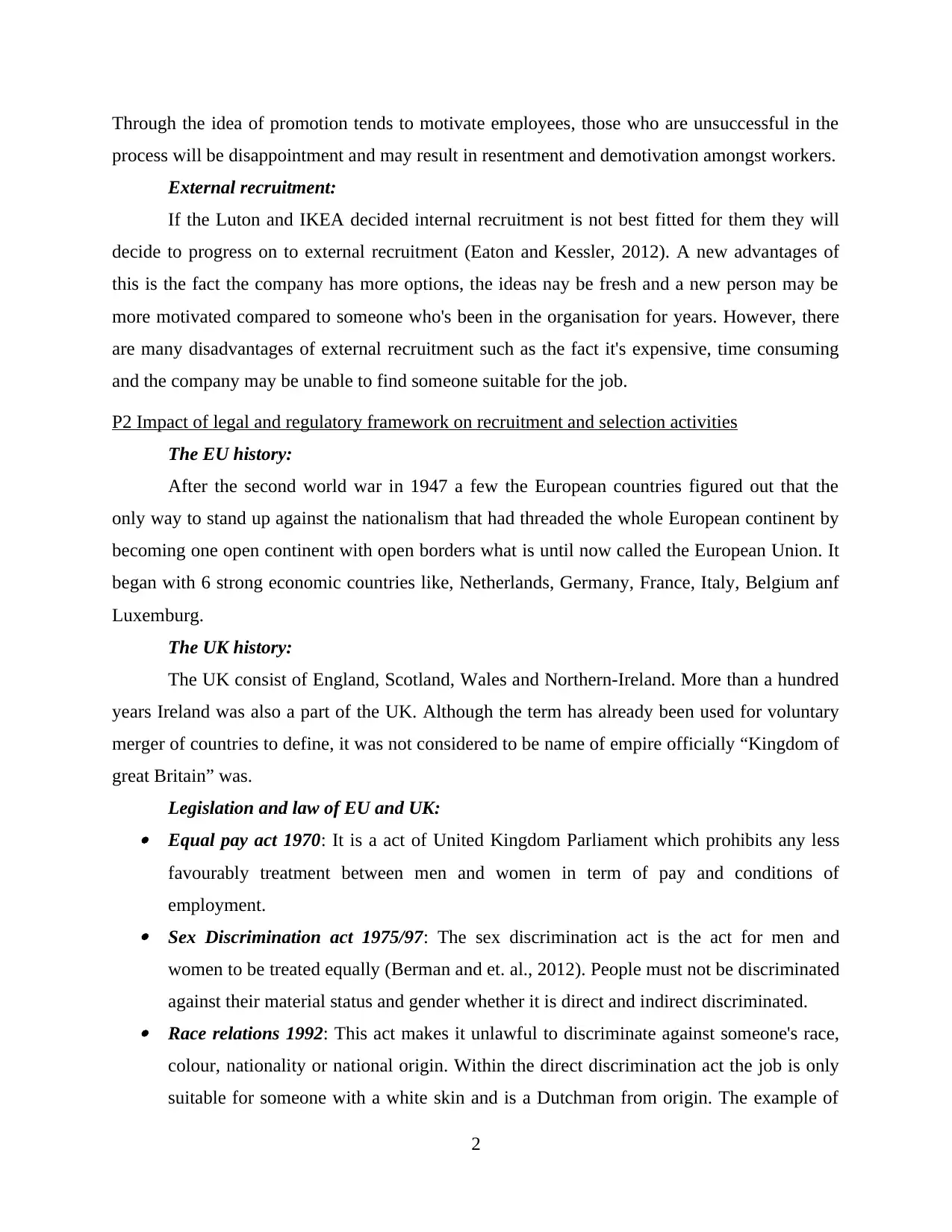
Through the idea of promotion tends to motivate employees, those who are unsuccessful in the
process will be disappointment and may result in resentment and demotivation amongst workers.
External recruitment:
If the Luton and IKEA decided internal recruitment is not best fitted for them they will
decide to progress on to external recruitment (Eaton and Kessler, 2012). A new advantages of
this is the fact the company has more options, the ideas nay be fresh and a new person may be
more motivated compared to someone who's been in the organisation for years. However, there
are many disadvantages of external recruitment such as the fact it's expensive, time consuming
and the company may be unable to find someone suitable for the job.
P2 Impact of legal and regulatory framework on recruitment and selection activities
The EU history:
After the second world war in 1947 a few the European countries figured out that the
only way to stand up against the nationalism that had threaded the whole European continent by
becoming one open continent with open borders what is until now called the European Union. It
began with 6 strong economic countries like, Netherlands, Germany, France, Italy, Belgium anf
Luxemburg.
The UK history:
The UK consist of England, Scotland, Wales and Northern-Ireland. More than a hundred
years Ireland was also a part of the UK. Although the term has already been used for voluntary
merger of countries to define, it was not considered to be name of empire officially “Kingdom of
great Britain” was.
Legislation and law of EU and UK: Equal pay act 1970: It is a act of United Kingdom Parliament which prohibits any less
favourably treatment between men and women in term of pay and conditions of
employment. Sex Discrimination act 1975/97: The sex discrimination act is the act for men and
women to be treated equally (Berman and et. al., 2012). People must not be discriminated
against their material status and gender whether it is direct and indirect discriminated. Race relations 1992: This act makes it unlawful to discriminate against someone's race,
colour, nationality or national origin. Within the direct discrimination act the job is only
suitable for someone with a white skin and is a Dutchman from origin. The example of
2
process will be disappointment and may result in resentment and demotivation amongst workers.
External recruitment:
If the Luton and IKEA decided internal recruitment is not best fitted for them they will
decide to progress on to external recruitment (Eaton and Kessler, 2012). A new advantages of
this is the fact the company has more options, the ideas nay be fresh and a new person may be
more motivated compared to someone who's been in the organisation for years. However, there
are many disadvantages of external recruitment such as the fact it's expensive, time consuming
and the company may be unable to find someone suitable for the job.
P2 Impact of legal and regulatory framework on recruitment and selection activities
The EU history:
After the second world war in 1947 a few the European countries figured out that the
only way to stand up against the nationalism that had threaded the whole European continent by
becoming one open continent with open borders what is until now called the European Union. It
began with 6 strong economic countries like, Netherlands, Germany, France, Italy, Belgium anf
Luxemburg.
The UK history:
The UK consist of England, Scotland, Wales and Northern-Ireland. More than a hundred
years Ireland was also a part of the UK. Although the term has already been used for voluntary
merger of countries to define, it was not considered to be name of empire officially “Kingdom of
great Britain” was.
Legislation and law of EU and UK: Equal pay act 1970: It is a act of United Kingdom Parliament which prohibits any less
favourably treatment between men and women in term of pay and conditions of
employment. Sex Discrimination act 1975/97: The sex discrimination act is the act for men and
women to be treated equally (Berman and et. al., 2012). People must not be discriminated
against their material status and gender whether it is direct and indirect discriminated. Race relations 1992: This act makes it unlawful to discriminate against someone's race,
colour, nationality or national origin. Within the direct discrimination act the job is only
suitable for someone with a white skin and is a Dutchman from origin. The example of
2
Paraphrase This Document
Need a fresh take? Get an instant paraphrase of this document with our AI Paraphraser
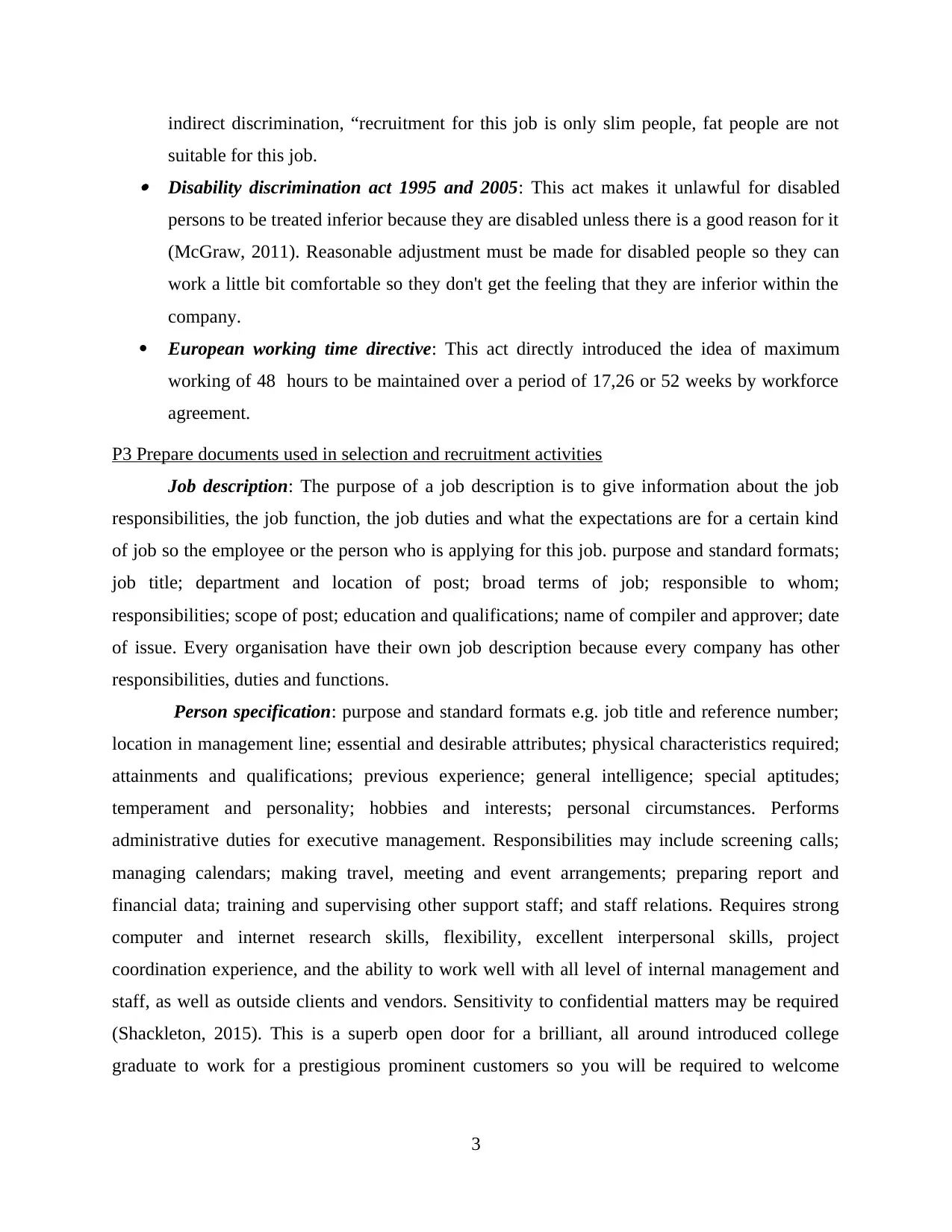
indirect discrimination, “recruitment for this job is only slim people, fat people are not
suitable for this job. Disability discrimination act 1995 and 2005: This act makes it unlawful for disabled
persons to be treated inferior because they are disabled unless there is a good reason for it
(McGraw, 2011). Reasonable adjustment must be made for disabled people so they can
work a little bit comfortable so they don't get the feeling that they are inferior within the
company.
European working time directive: This act directly introduced the idea of maximum
working of 48 hours to be maintained over a period of 17,26 or 52 weeks by workforce
agreement.
P3 Prepare documents used in selection and recruitment activities
Job description: The purpose of a job description is to give information about the job
responsibilities, the job function, the job duties and what the expectations are for a certain kind
of job so the employee or the person who is applying for this job. purpose and standard formats;
job title; department and location of post; broad terms of job; responsible to whom;
responsibilities; scope of post; education and qualifications; name of compiler and approver; date
of issue. Every organisation have their own job description because every company has other
responsibilities, duties and functions.
Person specification: purpose and standard formats e.g. job title and reference number;
location in management line; essential and desirable attributes; physical characteristics required;
attainments and qualifications; previous experience; general intelligence; special aptitudes;
temperament and personality; hobbies and interests; personal circumstances. Performs
administrative duties for executive management. Responsibilities may include screening calls;
managing calendars; making travel, meeting and event arrangements; preparing report and
financial data; training and supervising other support staff; and staff relations. Requires strong
computer and internet research skills, flexibility, excellent interpersonal skills, project
coordination experience, and the ability to work well with all level of internal management and
staff, as well as outside clients and vendors. Sensitivity to confidential matters may be required
(Shackleton, 2015). This is a superb open door for a brilliant, all around introduced college
graduate to work for a prestigious prominent customers so you will be required to welcome
3
suitable for this job. Disability discrimination act 1995 and 2005: This act makes it unlawful for disabled
persons to be treated inferior because they are disabled unless there is a good reason for it
(McGraw, 2011). Reasonable adjustment must be made for disabled people so they can
work a little bit comfortable so they don't get the feeling that they are inferior within the
company.
European working time directive: This act directly introduced the idea of maximum
working of 48 hours to be maintained over a period of 17,26 or 52 weeks by workforce
agreement.
P3 Prepare documents used in selection and recruitment activities
Job description: The purpose of a job description is to give information about the job
responsibilities, the job function, the job duties and what the expectations are for a certain kind
of job so the employee or the person who is applying for this job. purpose and standard formats;
job title; department and location of post; broad terms of job; responsible to whom;
responsibilities; scope of post; education and qualifications; name of compiler and approver; date
of issue. Every organisation have their own job description because every company has other
responsibilities, duties and functions.
Person specification: purpose and standard formats e.g. job title and reference number;
location in management line; essential and desirable attributes; physical characteristics required;
attainments and qualifications; previous experience; general intelligence; special aptitudes;
temperament and personality; hobbies and interests; personal circumstances. Performs
administrative duties for executive management. Responsibilities may include screening calls;
managing calendars; making travel, meeting and event arrangements; preparing report and
financial data; training and supervising other support staff; and staff relations. Requires strong
computer and internet research skills, flexibility, excellent interpersonal skills, project
coordination experience, and the ability to work well with all level of internal management and
staff, as well as outside clients and vendors. Sensitivity to confidential matters may be required
(Shackleton, 2015). This is a superb open door for a brilliant, all around introduced college
graduate to work for a prestigious prominent customers so you will be required to welcome
3
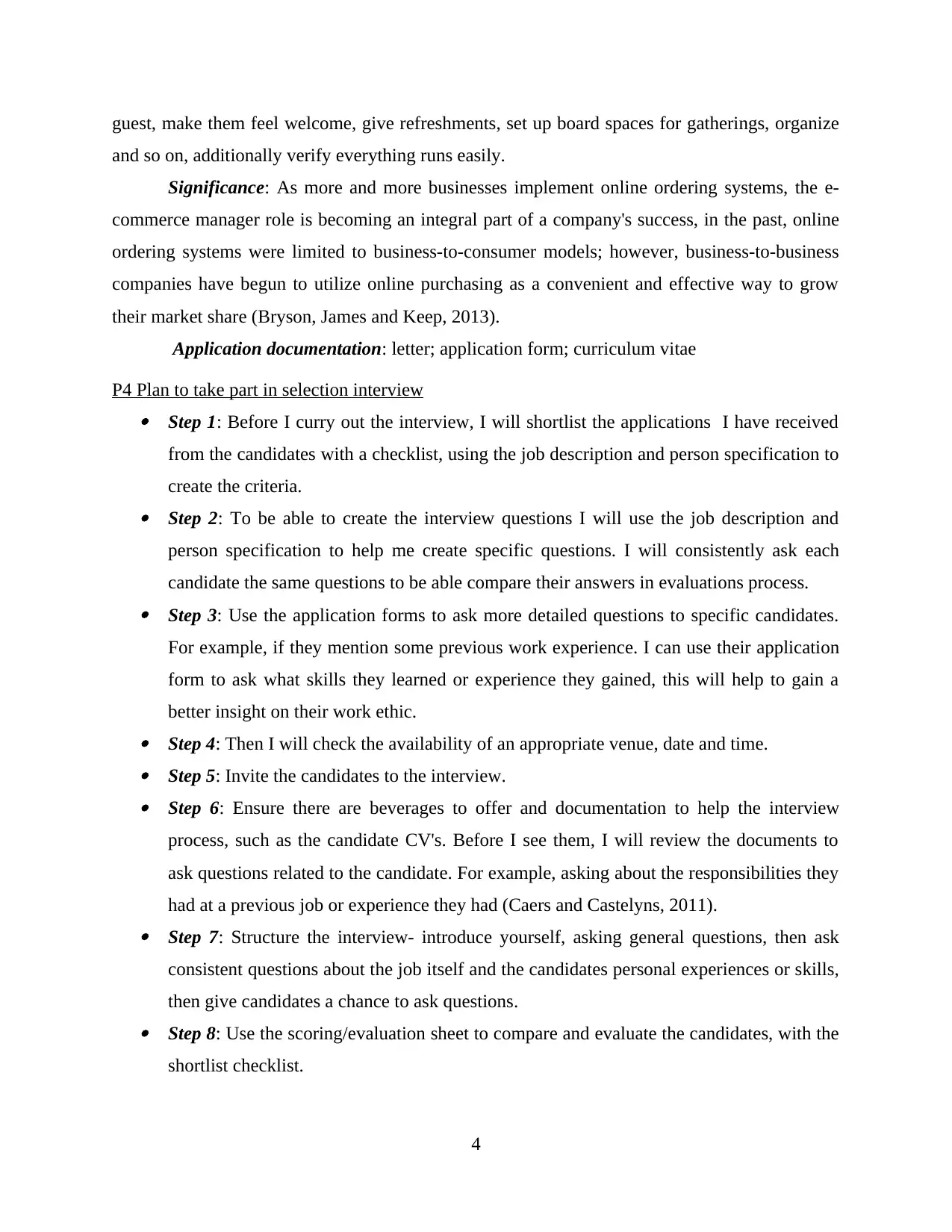
guest, make them feel welcome, give refreshments, set up board spaces for gatherings, organize
and so on, additionally verify everything runs easily.
Significance: As more and more businesses implement online ordering systems, the e-
commerce manager role is becoming an integral part of a company's success, in the past, online
ordering systems were limited to business-to-consumer models; however, business-to-business
companies have begun to utilize online purchasing as a convenient and effective way to grow
their market share (Bryson, James and Keep, 2013).
Application documentation: letter; application form; curriculum vitae
P4 Plan to take part in selection interview Step 1: Before I curry out the interview, I will shortlist the applications I have received
from the candidates with a checklist, using the job description and person specification to
create the criteria. Step 2: To be able to create the interview questions I will use the job description and
person specification to help me create specific questions. I will consistently ask each
candidate the same questions to be able compare their answers in evaluations process. Step 3: Use the application forms to ask more detailed questions to specific candidates.
For example, if they mention some previous work experience. I can use their application
form to ask what skills they learned or experience they gained, this will help to gain a
better insight on their work ethic. Step 4: Then I will check the availability of an appropriate venue, date and time. Step 5: Invite the candidates to the interview. Step 6: Ensure there are beverages to offer and documentation to help the interview
process, such as the candidate CV's. Before I see them, I will review the documents to
ask questions related to the candidate. For example, asking about the responsibilities they
had at a previous job or experience they had (Caers and Castelyns, 2011). Step 7: Structure the interview- introduce yourself, asking general questions, then ask
consistent questions about the job itself and the candidates personal experiences or skills,
then give candidates a chance to ask questions. Step 8: Use the scoring/evaluation sheet to compare and evaluate the candidates, with the
shortlist checklist.
4
and so on, additionally verify everything runs easily.
Significance: As more and more businesses implement online ordering systems, the e-
commerce manager role is becoming an integral part of a company's success, in the past, online
ordering systems were limited to business-to-consumer models; however, business-to-business
companies have begun to utilize online purchasing as a convenient and effective way to grow
their market share (Bryson, James and Keep, 2013).
Application documentation: letter; application form; curriculum vitae
P4 Plan to take part in selection interview Step 1: Before I curry out the interview, I will shortlist the applications I have received
from the candidates with a checklist, using the job description and person specification to
create the criteria. Step 2: To be able to create the interview questions I will use the job description and
person specification to help me create specific questions. I will consistently ask each
candidate the same questions to be able compare their answers in evaluations process. Step 3: Use the application forms to ask more detailed questions to specific candidates.
For example, if they mention some previous work experience. I can use their application
form to ask what skills they learned or experience they gained, this will help to gain a
better insight on their work ethic. Step 4: Then I will check the availability of an appropriate venue, date and time. Step 5: Invite the candidates to the interview. Step 6: Ensure there are beverages to offer and documentation to help the interview
process, such as the candidate CV's. Before I see them, I will review the documents to
ask questions related to the candidate. For example, asking about the responsibilities they
had at a previous job or experience they had (Caers and Castelyns, 2011). Step 7: Structure the interview- introduce yourself, asking general questions, then ask
consistent questions about the job itself and the candidates personal experiences or skills,
then give candidates a chance to ask questions. Step 8: Use the scoring/evaluation sheet to compare and evaluate the candidates, with the
shortlist checklist.
4
⊘ This is a preview!⊘
Do you want full access?
Subscribe today to unlock all pages.

Trusted by 1+ million students worldwide
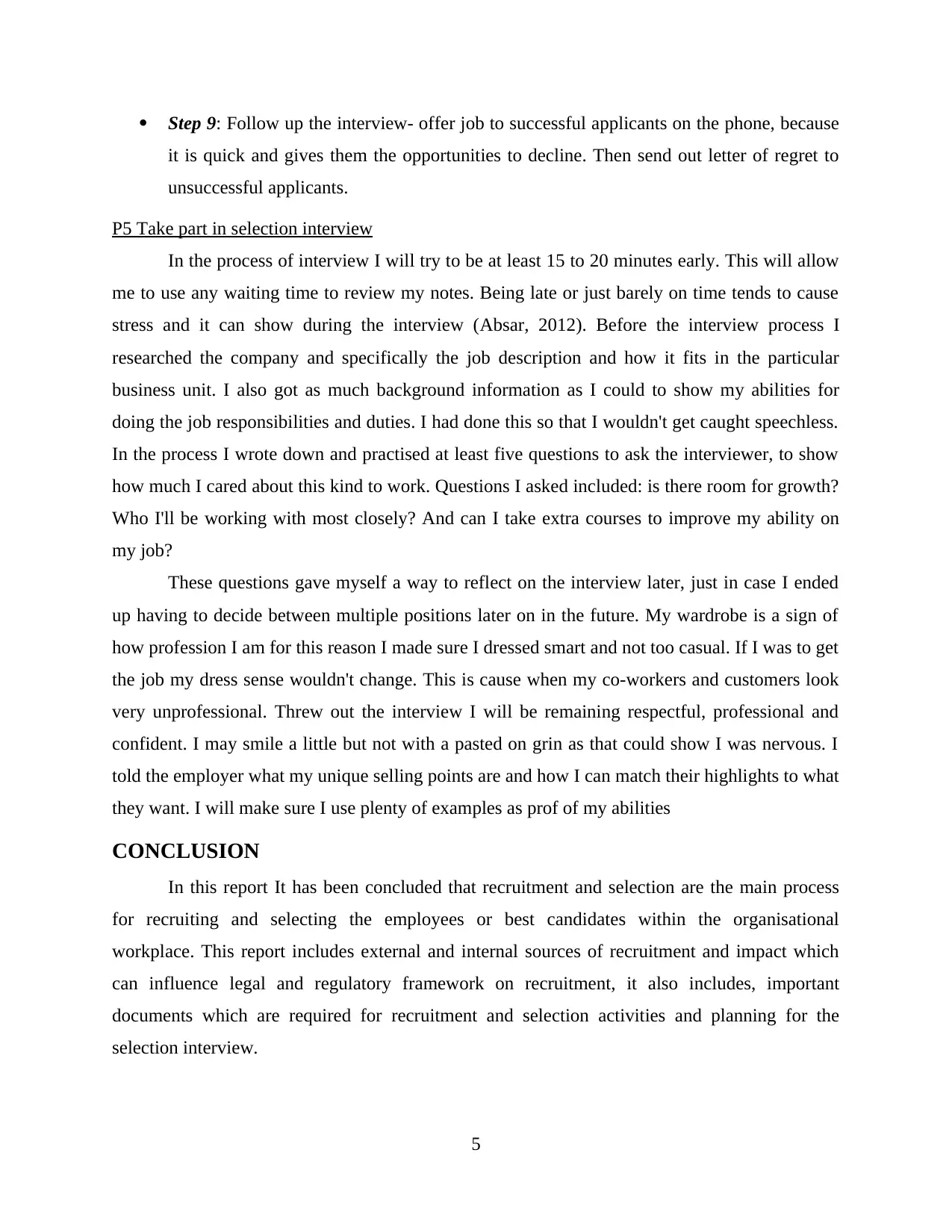
Step 9: Follow up the interview- offer job to successful applicants on the phone, because
it is quick and gives them the opportunities to decline. Then send out letter of regret to
unsuccessful applicants.
P5 Take part in selection interview
In the process of interview I will try to be at least 15 to 20 minutes early. This will allow
me to use any waiting time to review my notes. Being late or just barely on time tends to cause
stress and it can show during the interview (Absar, 2012). Before the interview process I
researched the company and specifically the job description and how it fits in the particular
business unit. I also got as much background information as I could to show my abilities for
doing the job responsibilities and duties. I had done this so that I wouldn't get caught speechless.
In the process I wrote down and practised at least five questions to ask the interviewer, to show
how much I cared about this kind to work. Questions I asked included: is there room for growth?
Who I'll be working with most closely? And can I take extra courses to improve my ability on
my job?
These questions gave myself a way to reflect on the interview later, just in case I ended
up having to decide between multiple positions later on in the future. My wardrobe is a sign of
how profession I am for this reason I made sure I dressed smart and not too casual. If I was to get
the job my dress sense wouldn't change. This is cause when my co-workers and customers look
very unprofessional. Threw out the interview I will be remaining respectful, professional and
confident. I may smile a little but not with a pasted on grin as that could show I was nervous. I
told the employer what my unique selling points are and how I can match their highlights to what
they want. I will make sure I use plenty of examples as prof of my abilities
CONCLUSION
In this report It has been concluded that recruitment and selection are the main process
for recruiting and selecting the employees or best candidates within the organisational
workplace. This report includes external and internal sources of recruitment and impact which
can influence legal and regulatory framework on recruitment, it also includes, important
documents which are required for recruitment and selection activities and planning for the
selection interview.
5
it is quick and gives them the opportunities to decline. Then send out letter of regret to
unsuccessful applicants.
P5 Take part in selection interview
In the process of interview I will try to be at least 15 to 20 minutes early. This will allow
me to use any waiting time to review my notes. Being late or just barely on time tends to cause
stress and it can show during the interview (Absar, 2012). Before the interview process I
researched the company and specifically the job description and how it fits in the particular
business unit. I also got as much background information as I could to show my abilities for
doing the job responsibilities and duties. I had done this so that I wouldn't get caught speechless.
In the process I wrote down and practised at least five questions to ask the interviewer, to show
how much I cared about this kind to work. Questions I asked included: is there room for growth?
Who I'll be working with most closely? And can I take extra courses to improve my ability on
my job?
These questions gave myself a way to reflect on the interview later, just in case I ended
up having to decide between multiple positions later on in the future. My wardrobe is a sign of
how profession I am for this reason I made sure I dressed smart and not too casual. If I was to get
the job my dress sense wouldn't change. This is cause when my co-workers and customers look
very unprofessional. Threw out the interview I will be remaining respectful, professional and
confident. I may smile a little but not with a pasted on grin as that could show I was nervous. I
told the employer what my unique selling points are and how I can match their highlights to what
they want. I will make sure I use plenty of examples as prof of my abilities
CONCLUSION
In this report It has been concluded that recruitment and selection are the main process
for recruiting and selecting the employees or best candidates within the organisational
workplace. This report includes external and internal sources of recruitment and impact which
can influence legal and regulatory framework on recruitment, it also includes, important
documents which are required for recruitment and selection activities and planning for the
selection interview.
5
Paraphrase This Document
Need a fresh take? Get an instant paraphrase of this document with our AI Paraphraser
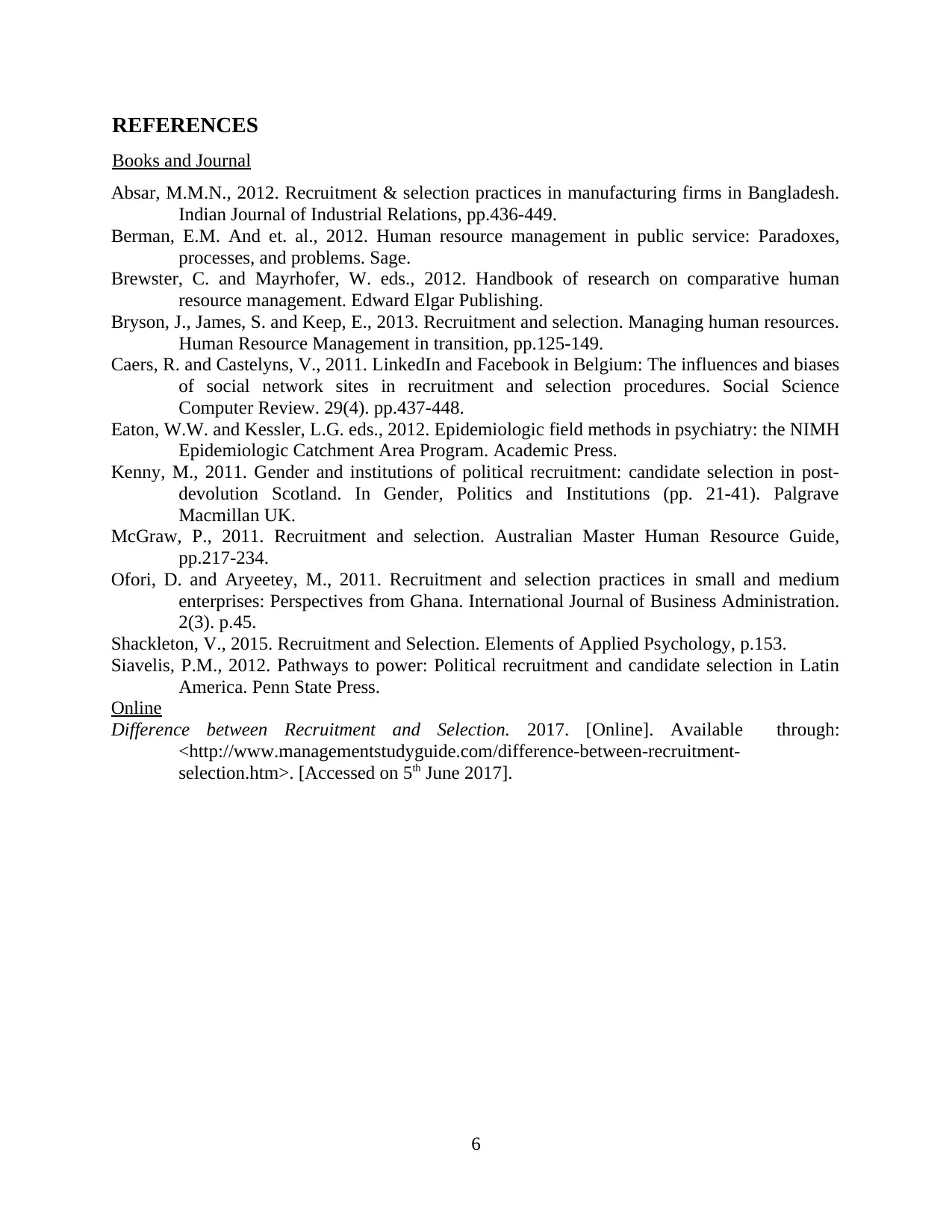
REFERENCES
Books and Journal
Absar, M.M.N., 2012. Recruitment & selection practices in manufacturing firms in Bangladesh.
Indian Journal of Industrial Relations, pp.436-449.
Berman, E.M. And et. al., 2012. Human resource management in public service: Paradoxes,
processes, and problems. Sage.
Brewster, C. and Mayrhofer, W. eds., 2012. Handbook of research on comparative human
resource management. Edward Elgar Publishing.
Bryson, J., James, S. and Keep, E., 2013. Recruitment and selection. Managing human resources.
Human Resource Management in transition, pp.125-149.
Caers, R. and Castelyns, V., 2011. LinkedIn and Facebook in Belgium: The influences and biases
of social network sites in recruitment and selection procedures. Social Science
Computer Review. 29(4). pp.437-448.
Eaton, W.W. and Kessler, L.G. eds., 2012. Epidemiologic field methods in psychiatry: the NIMH
Epidemiologic Catchment Area Program. Academic Press.
Kenny, M., 2011. Gender and institutions of political recruitment: candidate selection in post-
devolution Scotland. In Gender, Politics and Institutions (pp. 21-41). Palgrave
Macmillan UK.
McGraw, P., 2011. Recruitment and selection. Australian Master Human Resource Guide,
pp.217-234.
Ofori, D. and Aryeetey, M., 2011. Recruitment and selection practices in small and medium
enterprises: Perspectives from Ghana. International Journal of Business Administration.
2(3). p.45.
Shackleton, V., 2015. Recruitment and Selection. Elements of Applied Psychology, p.153.
Siavelis, P.M., 2012. Pathways to power: Political recruitment and candidate selection in Latin
America. Penn State Press.
Online
Difference between Recruitment and Selection. 2017. [Online]. Available through:
<http://www.managementstudyguide.com/difference-between-recruitment-
selection.htm>. [Accessed on 5th June 2017].
6
Books and Journal
Absar, M.M.N., 2012. Recruitment & selection practices in manufacturing firms in Bangladesh.
Indian Journal of Industrial Relations, pp.436-449.
Berman, E.M. And et. al., 2012. Human resource management in public service: Paradoxes,
processes, and problems. Sage.
Brewster, C. and Mayrhofer, W. eds., 2012. Handbook of research on comparative human
resource management. Edward Elgar Publishing.
Bryson, J., James, S. and Keep, E., 2013. Recruitment and selection. Managing human resources.
Human Resource Management in transition, pp.125-149.
Caers, R. and Castelyns, V., 2011. LinkedIn and Facebook in Belgium: The influences and biases
of social network sites in recruitment and selection procedures. Social Science
Computer Review. 29(4). pp.437-448.
Eaton, W.W. and Kessler, L.G. eds., 2012. Epidemiologic field methods in psychiatry: the NIMH
Epidemiologic Catchment Area Program. Academic Press.
Kenny, M., 2011. Gender and institutions of political recruitment: candidate selection in post-
devolution Scotland. In Gender, Politics and Institutions (pp. 21-41). Palgrave
Macmillan UK.
McGraw, P., 2011. Recruitment and selection. Australian Master Human Resource Guide,
pp.217-234.
Ofori, D. and Aryeetey, M., 2011. Recruitment and selection practices in small and medium
enterprises: Perspectives from Ghana. International Journal of Business Administration.
2(3). p.45.
Shackleton, V., 2015. Recruitment and Selection. Elements of Applied Psychology, p.153.
Siavelis, P.M., 2012. Pathways to power: Political recruitment and candidate selection in Latin
America. Penn State Press.
Online
Difference between Recruitment and Selection. 2017. [Online]. Available through:
<http://www.managementstudyguide.com/difference-between-recruitment-
selection.htm>. [Accessed on 5th June 2017].
6
1 out of 8
Related Documents
Your All-in-One AI-Powered Toolkit for Academic Success.
+13062052269
info@desklib.com
Available 24*7 on WhatsApp / Email
![[object Object]](/_next/static/media/star-bottom.7253800d.svg)
Unlock your academic potential
Copyright © 2020–2025 A2Z Services. All Rights Reserved. Developed and managed by ZUCOL.





